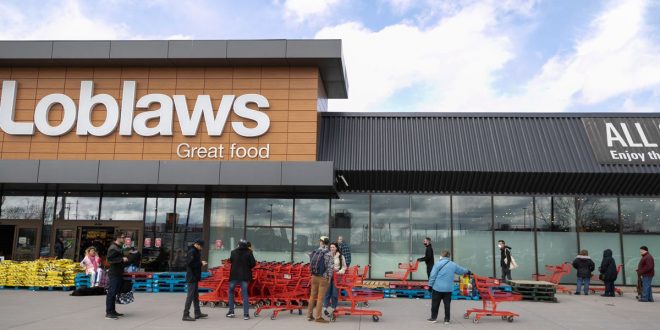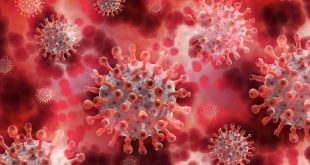Shoppers lineup outside a Loblaws grocery store in Toronto on March 20, 2020. On Monday, the Public Health Agency of Canada reported that 44 per cent of all COVID-19 cases in the country are the result of community transmission.
Melissa Tait/The Globe and Mail
Nearly half of Canada’s COVID-19 cases are now being acquired through community spread, a significant shift as the number of infections, hospitalizations and deaths mounts across the country.
Public-health experts say Canada faces a crucial few weeks during which hospitals will have an influx of severely ill patients that will strain their resources. On Monday, the country had nearly 1,500 confirmed cases of COVID-19, including 20 deaths. Last Monday, Canada had just more than 400 confirmed cases.
One reason for the spike is that COVID-19 is now spreading widely across Canada and is no longer confined to travellers returning from overseas.
Ontario and Quebec order non-essential businesses to close
More than a million people returned to Canada in a week amid coronavirus concerns
On Monday, the Public Health Agency of Canada reported that 44 per cent of all COVID-19 cases in the country are the result of community transmission, meaning they have no link to international travel. This means people could contract the virus while visiting friends or buying groceries.
“You could pick it up at any time, from anybody,” said Michael Gardam, an infection control expert and chief of staff at Toronto’s Humber River Hospital. “That’s why the general strategy of social distancing is so important. Anybody could have it.”
Dr. Gardam said adherence to requests to stay home is the key to stopping transmission.
“Truthfully, if all of us stayed more than two metres away from each other for 14 days, this thing would stop,” he said.
Quebec announced a dramatic spike in documented cases on Monday, representing both a change in its method for counting cases and spread into the community.
The province had 628 confirmed cases on Monday afternoon, an increase of 409 from Sunday. Through Sunday, it was testing in hospitals and confirming results at a provincial lab before adding them. It dropped the second step starting with Monday’s results, creating the one-day spike. The province did not specify how much of the increase was owing to the new accounting method.
Quebec public health director Horacio Arruda said somewhere between 40 per cent and 60 per cent of Quebec cases are now from community transmission. He added that the “epidemiological situation we are seeing is what we expected.”
In Ontario, local health officials said two people have died as result of community-acquired COVID-19 in the past week.
But Barbara Yaffe, Ontario’s associate chief medical officer of health, said it’s not clear community transmission is a problem in the province, and it’s possible that local health officials simply haven’t been able to properly connect new cases to international travel.
“I think we’re looking at cases where the local public-health unit has been unable to identify a source,” Dr. Yaffe said. “Obviously, they got [COVID-19] from somewhere. It didn’t come out of the air.”
Dr. Yaffe said it’s possible that “in some small percentage of cases,” there may be local transmission of COVID-19. She said that 17 per cent of the province’s COVID-19 cases can’t be linked to international travel or to close contact with people who tested positive, which means they could all be the result of community spread.
Health experts and the medical officers of health for Ottawa and Toronto, despite resistance from the province, have issued warnings about the reality of community spread and the risks it poses to the public.
Isaac Bogoch, an infectious diseases physician at Toronto General Hospital, said the provincial government needs to inform the public that COVID-19 is spreading in communities across Ontario so that more people take social distancing requests seriously.
“It would be very helpful for senior health leadership in Ontario to acknowledge that there is both travel-related and community-acquired cases of COVID-19, and that now, more than ever, it’s extremely important to adhere to the physical distancing measures recommended by public-health officials,” Dr. Bogoch said.
Two deaths linked to community transmission in Ontario are a concern, health experts say, because they represent the tip of the iceberg in terms of the total extent of COVID-19 spread. Only a small percentage of people with the virus become severely ill, and it typically takes a few weeks from the onset of infection until death. So that means COVID-19 has been spreading locally in communities throughout Ontario for weeks, with most cases undetected.
Many people have mild symptoms and may not realize they are infected. Also, Ontario doesn’t test people unless they are severely ill or in a high-risk group, such as health-care workers or long-term care residents. That’s why experts believe the true extent of the disease is vastly underestimated.
As a result, they want governments to do more to warn people they could become infected if they continue to interact with friends, extended family or others.
“To not be very open about community spread is mind boggling to me. Very clearly, there is community spread going on,” Dr. Gardam said. “Now is not the time to be vague. Now, I would argue, is the time to be very explicit about what you want people to do.”
Federal and provincial leaders stepped up their warnings on Monday about the need for people to stay home and avoid gathering with others.
“Enough is enough. Go home and stay home,” Prime Minister Justin Trudeau said on Monday. “This is what we all need to be doing.”
The premiers of Ontario and Quebec also ordered all non-essential businesses to close temporarily.
With a report from Les Perreaux
Sign up for the Coronavirus Update newsletter to read the day’s essential coronavirus news, features and explainers written by Globe reporters.
 The Argus Report Read about it!
The Argus Report Read about it!





